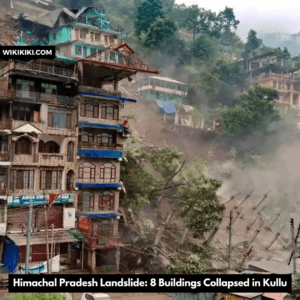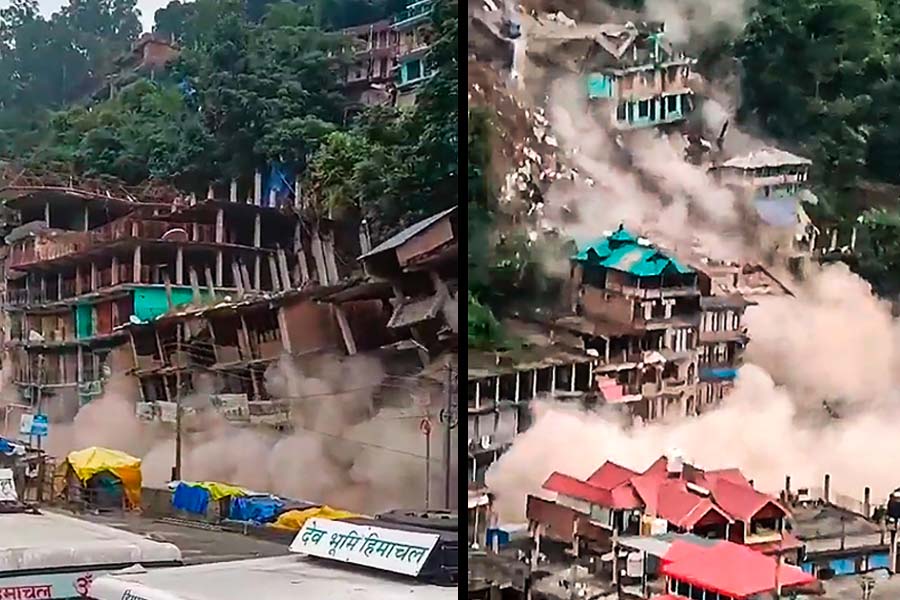Himachal Pradesh, known for its peaceful magnificence and rich green slopes, has been dove into a condition of strife and demolition because of relentless rainfall and catastrophic landslide. The monsoon season that started on June 24th has carried with it a progression of disasters, bringing about loss of lives, destruction of property, and a trail of despair.
As the rain continues to pour down unabated, the state’s weakness to these natural forces has been starkly highlighted, leading to the declaration of a ‘natural calamity affected area.

Also Read: Greece Wildfire: 18 Bodies Found in Wildfire Zone
As a rain began over Himachal Pradesh, the serenity was broken by the stunning roars of landslides. On a portentous day in Anni town of Kullu district, several buildings collapsed like a house of cards due to these landslides.
The horrifying scenes captured in videos shared by ANI depicted the terrifying power of nature as structures crumbled into rubble.
Despite the fact that there were no immediate reports of casualties, the damage was catastrophic. This incident was not an isolated one; it was a grim reminder of the series of rain-related disasters that had been haunting the state.
The statistics portray the demolition. Since the monsoon’s onset, a staggering 238 lives have been lost, with an additional 40 people reported missing. The period of August alone seen 120 rain related fatalities, underlining the direness of the circumstance.
Also Read: Colombia: 6.3 Magnitude Earthquake, 1 Dead
As structures imploded and landslides wreaked havoc, over 12,100 houses suffered significant damage, leaving countless families displaced and without shelter. The economic toll was no less severe, with the state government estimating losses amounting to a staggering ₹10,000 crore.
Several factors converged to create this disastrous situation. The steep slopes of the region, while providing stunning vistas, also made it susceptible to landslides.
The shortfall of appropriate seepage systems exacerbated the issue, causing rainwater to accumulate and destabilize the soil further.
The heavy and incessant rainfall acted as a trigger, loosening the earth and increasing the likelihood of landslides. Also, the development of buildings on these unstable terrains amplified the vulnerability, as the land caved in due to its weakened state.
Also Read: Tenerife Island: Thousands Evacuated as wildfire Spreads
Despite this calamity, the authorities swung into action. The District Disaster Management Centre became the nerve center for coordination and response. Evacuation efforts were prioritized, and buildings deemed at risk were vacated, potentially averting more casualties.
The issuance of red and orange cautions by the meteorological office served as early alerts, permitting occupants to get ready and authorities to mobilize resources. However, the scale of the disaster exposed the need for more robust disaster preparedness and resilient infrastructure.
Himachal Pradesh’s ecological sensitivity was laid bare by these events. The cloudbursts, landslides, and flash floods wreaked havoc on the delicate ecosystem.
The state’s rivers and streams swelled, causing concerns of flooding in the areas along their banks. The destruction of trees and vegetation further heightened the environmental impact.
The incidents prompted discussions on the need for sustainable development practices that take into account the fragility of the region’s ecosystem.
Also Read: Canada Wildfire Forces All 20000 Yellowknife Residents to Evacuate
Top Sources Related to Himachal Pradesh Landslide: 8 buildings Collapsed in Kullu (For R&D)
Times of India:
Sources Related to Floods in July and August Around the World (For R&D)
- China floods: Xi Jinping urges action as rains kill 15 and displace thousands
- At Least 1 Dead as Heavy Rains Set Off Flash Flooding in New York
- Mongolia – Floods
- Assam Floods: About 18,000 People Suffer From Terrible Flood In Dhemaji District
- At least 50 dead in Pakistan monsoon floods since end of June
- New Delhi Floods: Deadly Monsoon Rains, leaving 15 Dead
- Japan Floods: Heavy Rains Causes Floods and Landslides, 1 Dead
- South Korea Floods: At Least 26 Dead and Over 1000 Evacuated
- Central Russia:10 Dead, Including 3 Children as Strong Winds hit Tourist Camp
- Typhoon Doksuri: Beijing’s Heaviest Rain in a Decade Kills at Least 11
- Slovenia Floods: At least 2 Dead, Forcing Evacuations
- Georgia: 11 Killed in Landslide at Mountain Resort Town of Shovi
- Alaska: Houses Swept Away by Glacial Floods in Juneau
- Nepal: At Least 38 Killed, Several Missing in Floods And Landslides
- China: 21 Killed, 6 Missing After Mudslide in Xi’an
- Hurricane Hilary hits California after Lashing Mexico
- Pakistan: Floods Force Evacuation of Almost 100,000 People






















